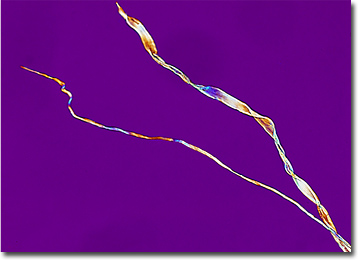Polarized Light Microscopy Digital Image Gallery
Silver Cotton Fibers
Cotton is one of the principal agricultural crops grown around the world and is utilized to fabricate a tremendous array of items, despite the increasing use of synthetic fibers. Among the chief cotton-producing countries are China, the United States, India, Pakistan, and Brazil.

Cotton is a seed-hair fiber that is derived from several different plants in the genus Gossypium of the family Malvaceae, which grow best in warm climates. Evidence indicates that these plants, which are native to most subtropical regions, were grown and harvested for their fiber well before any written records of human activity were produced. In fact, it is believed that as early as 3,000 BC inhabitants of India were taking advantage of the highly useful cotton plants and their fibers. Since such early efforts in the industry, the development of innumerable technological advances has made cotton production a much faster and more economical undertaking. Perhaps the most important of these advances was the invention of the cotton gin in 1793, which provided a mechanical means of separating seeds from the cotton fibers and helped the British cotton industry surpass the wool and flax industries in output and economic importance.
Individual cotton fibers naturally flatten and twist when they are dried. This characteristic makes it easier for cotton to be spun than most other materials because the fibers more readily interlock into threads. It also typically results in a stronger thread than many other fibers. Fabrics made from cotton, therefore, are extremely durable, as well as inexpensive to buy since there is such an abundance of cotton crops. Furthermore, cotton is absorbent, resistant to abrasion, and readily fashioned into an array of materials that range from thin, lightweight muslins to thick, heavy sailcloths and velveteens. The accommodating material is not only useful for textiles, however, but as a component in a broad range of commodities, such as paper, diapers, tea bags, and bandages.
